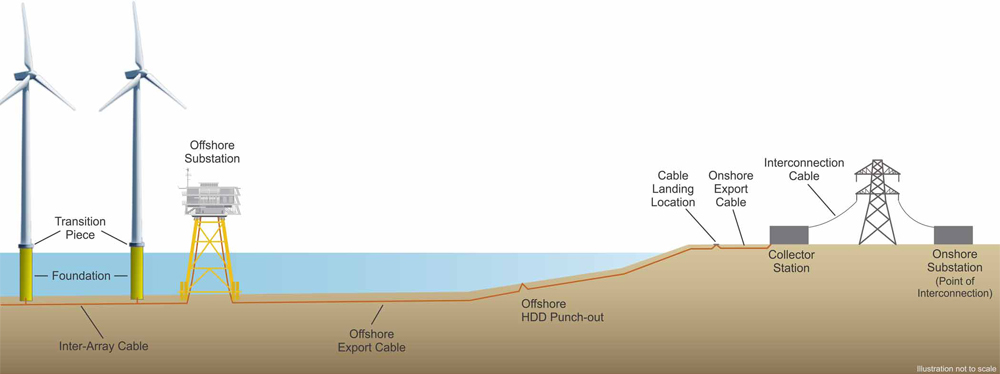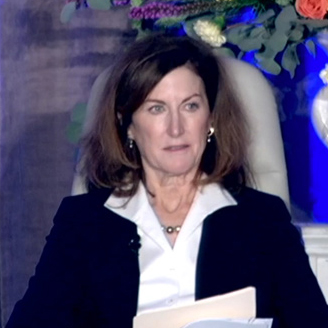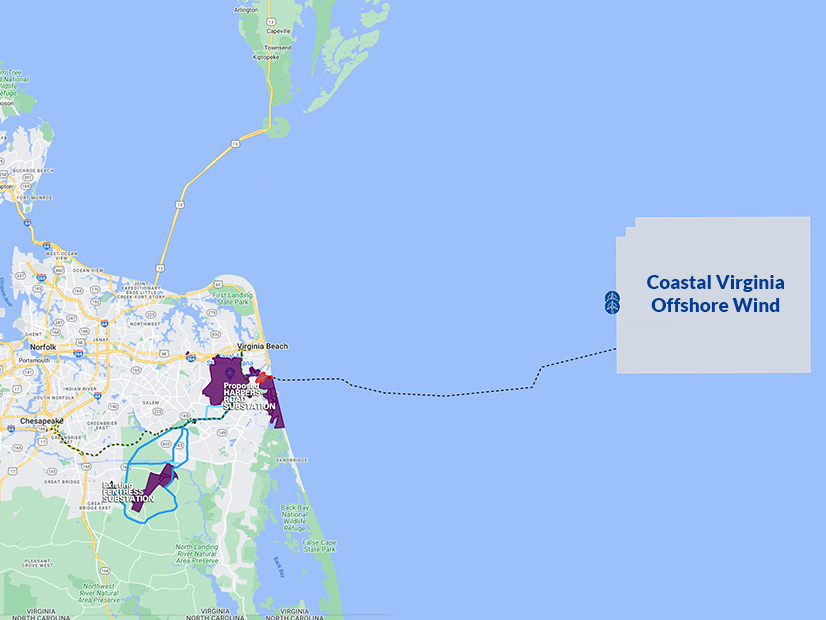Virginia regulators warily approved a $78.7 million rate hike for Dominion Energy’s 2.6-GW Coastal Virginia Offshore Wind (CVOW) project Friday, warning that the legislature had left ratepayers facing “unprecedented risks” of cost overruns and delays on the massive $21.5 billion project.
With a projected capital cost of $9.8 billion, the project “will likely be the largest capital investment, and single largest project” in the utility’s history, the State Corporation Commission (SCC) said in its 45-page order, which also approved the interconnection and transmission facilities to connect the project to the PJM grid (PUR-2021-00142). “The project will also likely be the costliest project being undertaken by any regulated utility in the United States, with the exception of Southern Co.’s ongoing Vogtle nuclear project, and will likely be the most expensive on a dollars-per-kilowatt of firm capacity basis.”
Total project costs, including financing costs minus investment tax credits, are estimated at $21.5 billion, including a $7.22 billion return on equity based on Dominion’s 9.35% ROE rate.
The new rate adjustment clause (Rider OSW) will cost a residential customer using 1,000 kWh/month an average monthly bill increase of $4.72 over the projected 35-year lifetime of the project, with a peak increase of $14.22 in 2027, the commission said.
Ratepayers at Risk
“While neither staff nor any respondent opposed approval of CVOW, significant concerns were raised throughout this proceeding regarding affordability and the financial risk to ratepayers,” the commission noted. “The project is truly distinctive in numerous respects, encompassing cost, size, technology, complexity, ownership and risk. … No other utility or independent developer has attempted to construct and operate an offshore wind project of this size in the United States.”
Unlike other East Coast states backing offshore wind, Virginia did not choose procurement models to mitigate the risk to ratepayers.
Instead, Dominion will construct, own and operate the project, with its costs presumed prudent under the 2020 Virginia Clean Economy Act (VCEA) as long as the total levelized cost of energy — including tax credits and the costs of transmission and distribution facilities — does not exceed 1.4 times the cost per megawatt-hour of a simple cycle combustion turbine.
“Every other state that is pursuing large-scale offshore wind is utilizing power purchase agreements or offshore renewable energy certificate contracts, which limits the risks to customers by shifting construction, operational and market risks from customers to the project’s owner,” the SCC noted.
Cost-control Protections
Acknowledging concerns raised by the Office of the Attorney General’s Division of Consumer Counsel, the state Department of Energy, Walmart, Clean Virginia and Appalachian Voices, the commission ordered Dominion to:
- file a notice with the SCC within 30 calendar days if it determines that total project costs are expected to exceed the current estimate, or if the final turbine installation is expected to be delayed beyond Feb. 4, 2027. The company currently projects an in-service date by the end of 2026;
- include any material changes to the project in each annual Rider OSW update application it files before the project’s commercial operation, and a written explanation for any cost overruns; and
- hold ratepayers harmless for the cost of replacement power if CVOW’s energy production fails to meet its projected 42% annual net capacity factor, as measured on a three-year rolling average.
Dominion contended “it would be inappropriate for the company to be put at risk if it fails to meet the capacity factor upon which it has justified and supported this project,” the SCC said. “We disagree. This particular risk for this particular project should not fall on the company’s customers.”
Dominion did not immediately respond to a request for comment on the SCC’s concerns. In a press release, Dominion CEO Robert Blue said the company was happy with the commission’s approval and is “reviewing the specifics of the order, particularly the performance requirement.”
The commission acknowledged that its 42% performance standard will not protect customers from cost overruns or abandonment costs, the latter of which “would not be inconsequential,” the commission warned. “Even if the project is abandoned at the end of 2023, Dominion still estimates it would have prudently incurred approximately $3.7 billion of costs to be recovered from customers.”
The commission warned rising commodity prices and supply chain problems could result in construction delays and cost overruns.
“As a first-mover project, there is no developed supply chain, including equipment suppliers, specialized installation vessels, and infrastructure to handle the transportation and installation of the equipment,” the SCC said. It noted that turbine supplier Siemens Gamesa has suffered supply chain disruptions and that the company has two installations ahead of CVOW that will be receiving the same turbines.
No EPC Contractor
The commission also said the designs for the turbines, monopiles, transition structures and other components have not been finalized and questioned whether Dominion’s 3% contingency estimate ($300 million) was sufficient “for a project of this size and risk.”
“Dominion has also opted not to use an engineering, procurement and construction (EPC) contractor on the project, which the record shows is a departure from how it has managed construction of prior generation facilities. In prior cases, the use of an EPC contractor enabled the company to shift materials, labor and schedule risk away from the company and its customers, as well as risk of construction delays and cost overruns,” the commission said. “In this case, however, Dominion is instead managing the project in-house using multiple interrelated contractors.”
The VCEA declared “in the public interest” the construction or purchase by a public utility up to 5,200 MW of offshore wind. Dominion’s choice of “a construction and ownership model that places most of the risks on customers … is one of the reasons why Clean Virginia seeks an independent assessment of whether the utility-owned model for this project should not be used for the next 2,600 MW tranche of offshore wind,” the SCC said.

Effective Sept. 1, Rider OSW will recover financing costs on $661.7 million in capital expenditures during the rate year, as well as allowance for funds used during construction accrued on Dominion’s books.
Like all VCEA-related costs, Rider OSW will be a non-bypassable charge generally paid by all Dominion retail customers — even those who purchase power from competitive service providers — with limited exceptions. “Prior to the VCEA, shopping customers would generally not be responsible for the costs of Dominion generation facilities to the extent they procure for their own energy and capacity from someone other than Dominion. The VCEA now directs that shopping customers pay for VCEA-related costs, with limited exceptions.”
Transmission
The project — 176 14.7-MW wind turbines that Dominion says will produce enough carbon-free power for up to 660,000 homes — will be located 27 miles off the coast of Virginia Beach.
The capital cost includes a projected $1.15 billion for the onshore Virginia facilities, including $774.3 million for transmission-related work and approximately $374.2 million for substation-related work (2021 dollars).
The SCC order approved Dominion’s route for the offshore export circuits and the route for the 4.4-mile underground route for its onshore export circuits from the cable landing to a new Harpers Switching Station. Also approved was an overhead route from Harpers to the existing Fentress Substation.
Transmission upgrades are estimated to be about $215 million. The final costs of transmission network upgrades are unknown because ongoing study work in the PJM generation queue was placed on hold to clear the current backlog.
“The transmission interconnection facilities are a significant component of this project, and [Dominion] has experienced delays and cost overruns on recent transmission projects,” the SCC said.
Jagdmann Suggests Legislative Action

In a concurrence, SCC Commissioner Judith Jagdmann observed that CVOW “is a legislatively favored project. If the elements of [the VCEA] are met, the costs of the project are presumed ‘reasonable and prudent’ — which means, in effect, ‘ratepayers pay,’” Jagdmann wrote.
But she said the General Assembly could reduce the impact on ratepayers by making general fund appropriations or authorizing the use of auction proceeds from the Regional Greenhouse Gas Initiative. “Such action may be appropriate given the public policy support for and economic development aspects of this project,” she wrote.
She said the legislature’s requirement for yearly cost recovery proceedings provide “in theory, the opportunity in upcoming sessions to determine if additional steps are warranted to reduce the economic burden that will be placed on Dominion’s customers as the project proceeds.”
“Timing may be of the essence,” she added. “In less than 18 months from now, Dominion plans to have spent close to $4 billion of capital costs on the project.”



